Business Finance Report: Financial Ratio Analysis of T-shirt Ltd
VerifiedAdded on 2022/12/30
|12
|3272
|1
Report
AI Summary
This report provides a comprehensive analysis of T-shirt Ltd's financial performance, covering key aspects of business finance. The report begins with an introduction to financial concepts and then dives into a detailed examination of the company's financial statements, including the statement of profit or loss and the statement of financial position. It analyzes financial ratios such as the current ratio, receivable turnover ratio, and payable turnover ratio to assess the company's liquidity and efficiency. The report also explains the concepts of accrual accounting versus cash accounting, discussing the benefits and limitations of each method. Furthermore, it explores the relationship between cash flow and profit and concludes with a discussion of budgeting techniques, defining budgets and explaining their purposes. The analysis provides insights into the company's financial health and offers recommendations for improvement.

BUSINESS FINANCE
Paraphrase This Document
Need a fresh take? Get an instant paraphrase of this document with our AI Paraphraser
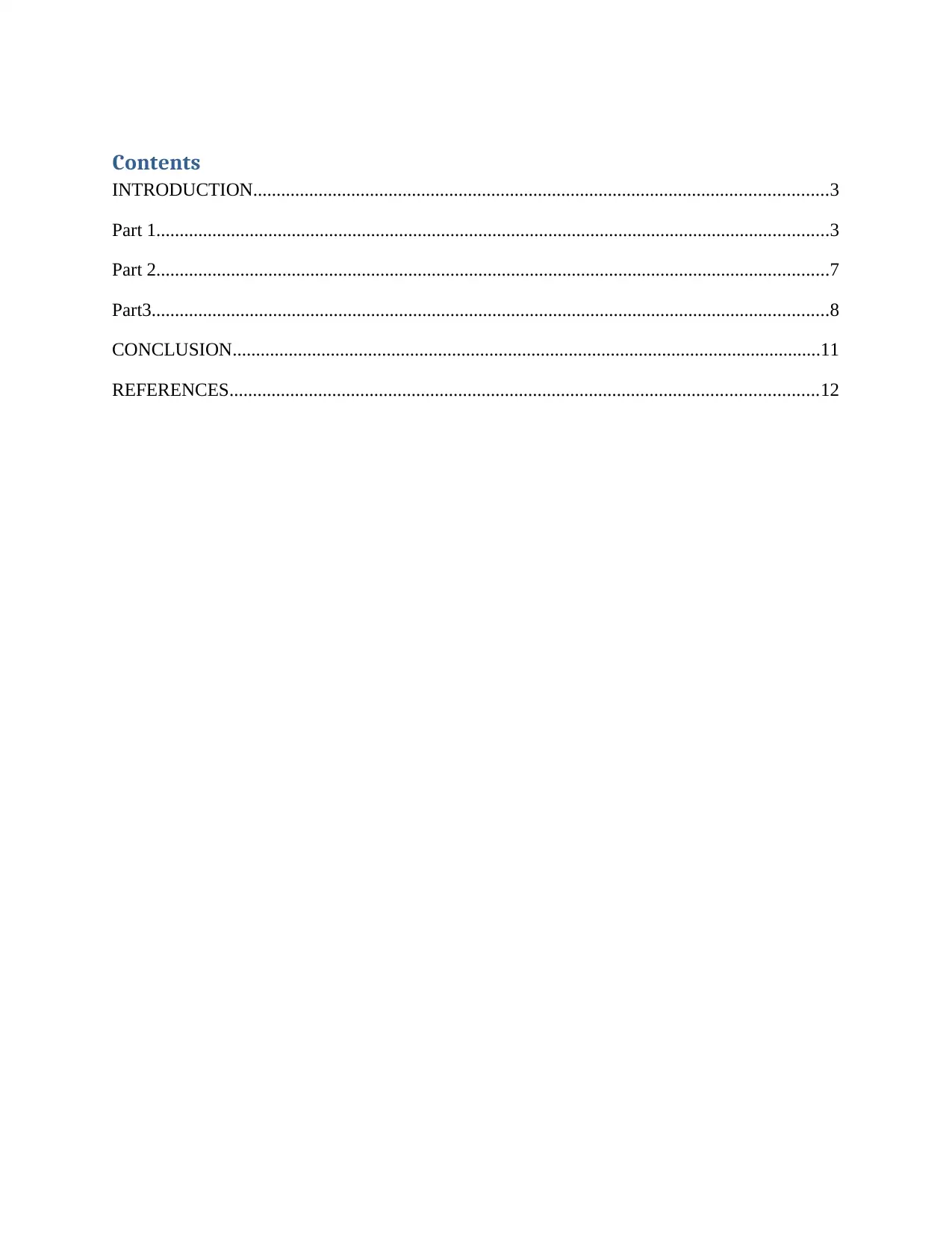
Contents
INTRODUCTION...........................................................................................................................3
Part 1................................................................................................................................................3
Part 2................................................................................................................................................7
Part3.................................................................................................................................................8
CONCLUSION..............................................................................................................................11
REFERENCES..............................................................................................................................12
INTRODUCTION...........................................................................................................................3
Part 1................................................................................................................................................3
Part 2................................................................................................................................................7
Part3.................................................................................................................................................8
CONCLUSION..............................................................................................................................11
REFERENCES..............................................................................................................................12
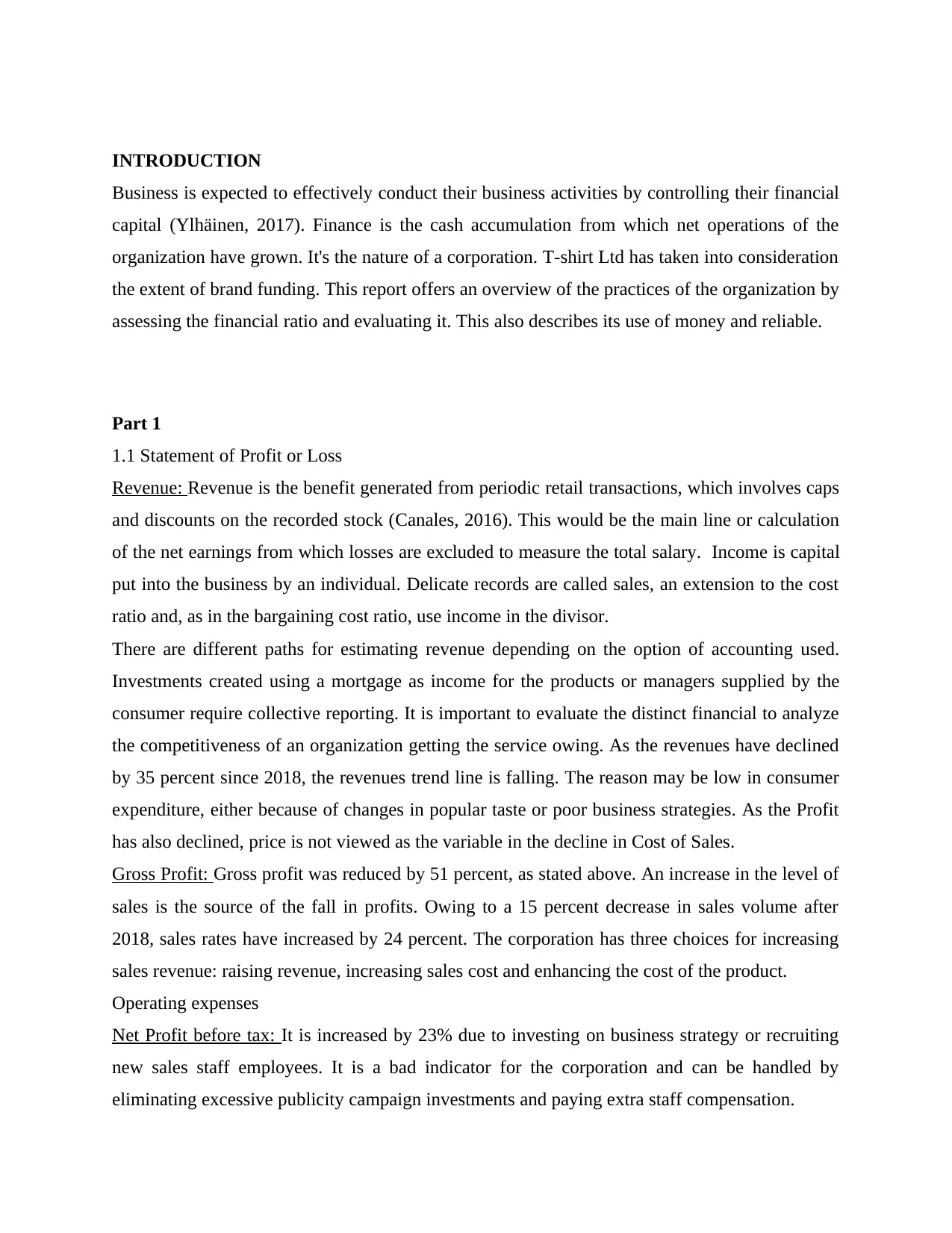
INTRODUCTION
Business is expected to effectively conduct their business activities by controlling their financial
capital (Ylhäinen, 2017). Finance is the cash accumulation from which net operations of the
organization have grown. It's the nature of a corporation. T-shirt Ltd has taken into consideration
the extent of brand funding. This report offers an overview of the practices of the organization by
assessing the financial ratio and evaluating it. This also describes its use of money and reliable.
Part 1
1.1 Statement of Profit or Loss
Revenue: Revenue is the benefit generated from periodic retail transactions, which involves caps
and discounts on the recorded stock (Canales, 2016). This would be the main line or calculation
of the net earnings from which losses are excluded to measure the total salary. Income is capital
put into the business by an individual. Delicate records are called sales, an extension to the cost
ratio and, as in the bargaining cost ratio, use income in the divisor.
There are different paths for estimating revenue depending on the option of accounting used.
Investments created using a mortgage as income for the products or managers supplied by the
consumer require collective reporting. It is important to evaluate the distinct financial to analyze
the competitiveness of an organization getting the service owing. As the revenues have declined
by 35 percent since 2018, the revenues trend line is falling. The reason may be low in consumer
expenditure, either because of changes in popular taste or poor business strategies. As the Profit
has also declined, price is not viewed as the variable in the decline in Cost of Sales.
Gross Profit: Gross profit was reduced by 51 percent, as stated above. An increase in the level of
sales is the source of the fall in profits. Owing to a 15 percent decrease in sales volume after
2018, sales rates have increased by 24 percent. The corporation has three choices for increasing
sales revenue: raising revenue, increasing sales cost and enhancing the cost of the product.
Operating expenses
Net Profit before tax: It is increased by 23% due to investing on business strategy or recruiting
new sales staff employees. It is a bad indicator for the corporation and can be handled by
eliminating excessive publicity campaign investments and paying extra staff compensation.
Business is expected to effectively conduct their business activities by controlling their financial
capital (Ylhäinen, 2017). Finance is the cash accumulation from which net operations of the
organization have grown. It's the nature of a corporation. T-shirt Ltd has taken into consideration
the extent of brand funding. This report offers an overview of the practices of the organization by
assessing the financial ratio and evaluating it. This also describes its use of money and reliable.
Part 1
1.1 Statement of Profit or Loss
Revenue: Revenue is the benefit generated from periodic retail transactions, which involves caps
and discounts on the recorded stock (Canales, 2016). This would be the main line or calculation
of the net earnings from which losses are excluded to measure the total salary. Income is capital
put into the business by an individual. Delicate records are called sales, an extension to the cost
ratio and, as in the bargaining cost ratio, use income in the divisor.
There are different paths for estimating revenue depending on the option of accounting used.
Investments created using a mortgage as income for the products or managers supplied by the
consumer require collective reporting. It is important to evaluate the distinct financial to analyze
the competitiveness of an organization getting the service owing. As the revenues have declined
by 35 percent since 2018, the revenues trend line is falling. The reason may be low in consumer
expenditure, either because of changes in popular taste or poor business strategies. As the Profit
has also declined, price is not viewed as the variable in the decline in Cost of Sales.
Gross Profit: Gross profit was reduced by 51 percent, as stated above. An increase in the level of
sales is the source of the fall in profits. Owing to a 15 percent decrease in sales volume after
2018, sales rates have increased by 24 percent. The corporation has three choices for increasing
sales revenue: raising revenue, increasing sales cost and enhancing the cost of the product.
Operating expenses
Net Profit before tax: It is increased by 23% due to investing on business strategy or recruiting
new sales staff employees. It is a bad indicator for the corporation and can be handled by
eliminating excessive publicity campaign investments and paying extra staff compensation.
⊘ This is a preview!⊘
Do you want full access?
Subscribe today to unlock all pages.

Trusted by 1+ million students worldwide
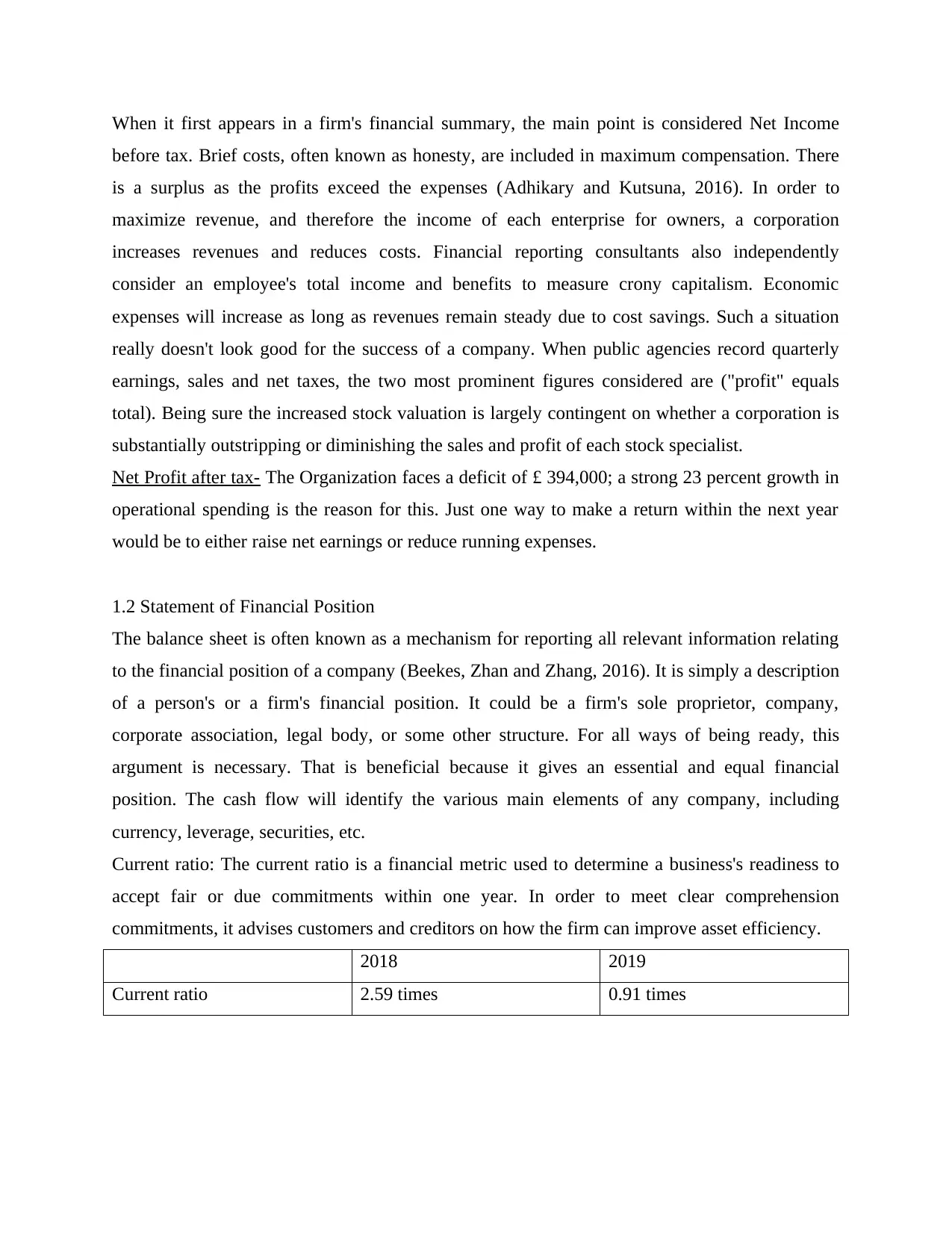
When it first appears in a firm's financial summary, the main point is considered Net Income
before tax. Brief costs, often known as honesty, are included in maximum compensation. There
is a surplus as the profits exceed the expenses (Adhikary and Kutsuna, 2016). In order to
maximize revenue, and therefore the income of each enterprise for owners, a corporation
increases revenues and reduces costs. Financial reporting consultants also independently
consider an employee's total income and benefits to measure crony capitalism. Economic
expenses will increase as long as revenues remain steady due to cost savings. Such a situation
really doesn't look good for the success of a company. When public agencies record quarterly
earnings, sales and net taxes, the two most prominent figures considered are ("profit" equals
total). Being sure the increased stock valuation is largely contingent on whether a corporation is
substantially outstripping or diminishing the sales and profit of each stock specialist.
Net Profit after tax- The Organization faces a deficit of £ 394,000; a strong 23 percent growth in
operational spending is the reason for this. Just one way to make a return within the next year
would be to either raise net earnings or reduce running expenses.
1.2 Statement of Financial Position
The balance sheet is often known as a mechanism for reporting all relevant information relating
to the financial position of a company (Beekes, Zhan and Zhang, 2016). It is simply a description
of a person's or a firm's financial position. It could be a firm's sole proprietor, company,
corporate association, legal body, or some other structure. For all ways of being ready, this
argument is necessary. That is beneficial because it gives an essential and equal financial
position. The cash flow will identify the various main elements of any company, including
currency, leverage, securities, etc.
Current ratio: The current ratio is a financial metric used to determine a business's readiness to
accept fair or due commitments within one year. In order to meet clear comprehension
commitments, it advises customers and creditors on how the firm can improve asset efficiency.
2018 2019
Current ratio 2.59 times 0.91 times
before tax. Brief costs, often known as honesty, are included in maximum compensation. There
is a surplus as the profits exceed the expenses (Adhikary and Kutsuna, 2016). In order to
maximize revenue, and therefore the income of each enterprise for owners, a corporation
increases revenues and reduces costs. Financial reporting consultants also independently
consider an employee's total income and benefits to measure crony capitalism. Economic
expenses will increase as long as revenues remain steady due to cost savings. Such a situation
really doesn't look good for the success of a company. When public agencies record quarterly
earnings, sales and net taxes, the two most prominent figures considered are ("profit" equals
total). Being sure the increased stock valuation is largely contingent on whether a corporation is
substantially outstripping or diminishing the sales and profit of each stock specialist.
Net Profit after tax- The Organization faces a deficit of £ 394,000; a strong 23 percent growth in
operational spending is the reason for this. Just one way to make a return within the next year
would be to either raise net earnings or reduce running expenses.
1.2 Statement of Financial Position
The balance sheet is often known as a mechanism for reporting all relevant information relating
to the financial position of a company (Beekes, Zhan and Zhang, 2016). It is simply a description
of a person's or a firm's financial position. It could be a firm's sole proprietor, company,
corporate association, legal body, or some other structure. For all ways of being ready, this
argument is necessary. That is beneficial because it gives an essential and equal financial
position. The cash flow will identify the various main elements of any company, including
currency, leverage, securities, etc.
Current ratio: The current ratio is a financial metric used to determine a business's readiness to
accept fair or due commitments within one year. In order to meet clear comprehension
commitments, it advises customers and creditors on how the firm can improve asset efficiency.
2018 2019
Current ratio 2.59 times 0.91 times
Paraphrase This Document
Need a fresh take? Get an instant paraphrase of this document with our AI Paraphraser
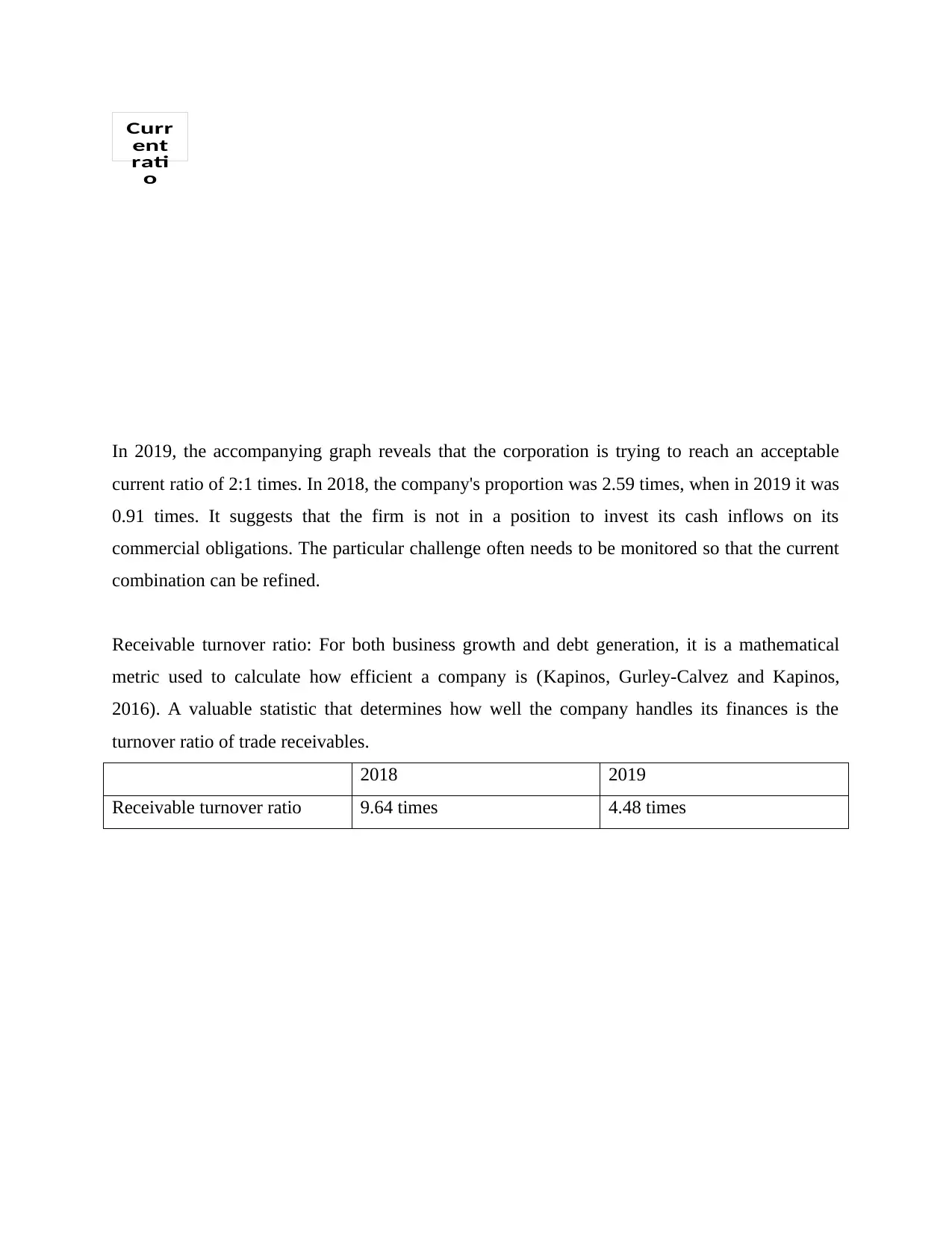
Curr
ent
rati
o
In 2019, the accompanying graph reveals that the corporation is trying to reach an acceptable
current ratio of 2:1 times. In 2018, the company's proportion was 2.59 times, when in 2019 it was
0.91 times. It suggests that the firm is not in a position to invest its cash inflows on its
commercial obligations. The particular challenge often needs to be monitored so that the current
combination can be refined.
Receivable turnover ratio: For both business growth and debt generation, it is a mathematical
metric used to calculate how efficient a company is (Kapinos, Gurley-Calvez and Kapinos,
2016). A valuable statistic that determines how well the company handles its finances is the
turnover ratio of trade receivables.
2018 2019
Receivable turnover ratio 9.64 times 4.48 times
ent
rati
o
In 2019, the accompanying graph reveals that the corporation is trying to reach an acceptable
current ratio of 2:1 times. In 2018, the company's proportion was 2.59 times, when in 2019 it was
0.91 times. It suggests that the firm is not in a position to invest its cash inflows on its
commercial obligations. The particular challenge often needs to be monitored so that the current
combination can be refined.
Receivable turnover ratio: For both business growth and debt generation, it is a mathematical
metric used to calculate how efficient a company is (Kapinos, Gurley-Calvez and Kapinos,
2016). A valuable statistic that determines how well the company handles its finances is the
turnover ratio of trade receivables.
2018 2019
Receivable turnover ratio 9.64 times 4.48 times
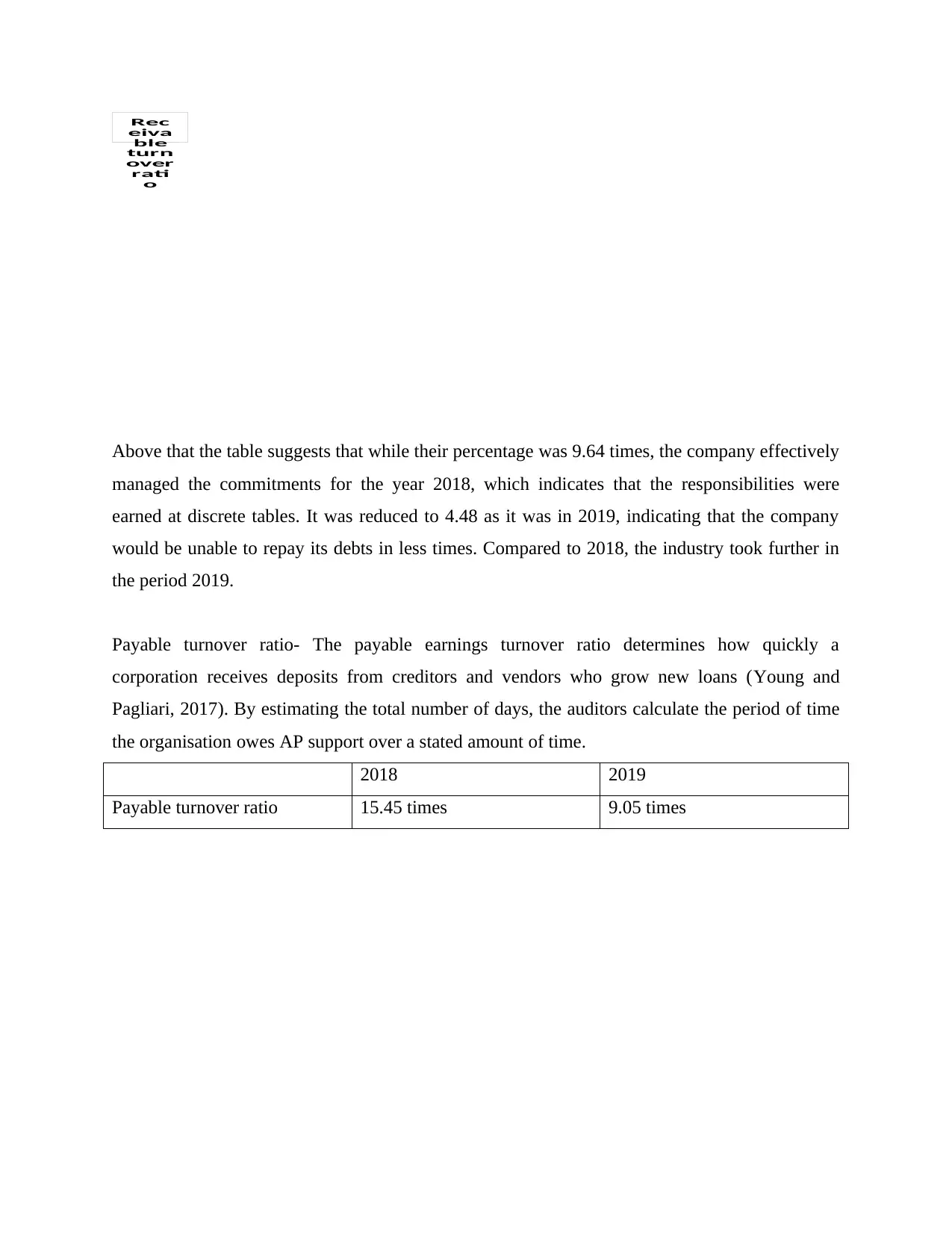
Rec
eiva
ble
turn
over
rati
o
Above that the table suggests that while their percentage was 9.64 times, the company effectively
managed the commitments for the year 2018, which indicates that the responsibilities were
earned at discrete tables. It was reduced to 4.48 as it was in 2019, indicating that the company
would be unable to repay its debts in less times. Compared to 2018, the industry took further in
the period 2019.
Payable turnover ratio- The payable earnings turnover ratio determines how quickly a
corporation receives deposits from creditors and vendors who grow new loans (Young and
Pagliari, 2017). By estimating the total number of days, the auditors calculate the period of time
the organisation owes AP support over a stated amount of time.
2018 2019
Payable turnover ratio 15.45 times 9.05 times
eiva
ble
turn
over
rati
o
Above that the table suggests that while their percentage was 9.64 times, the company effectively
managed the commitments for the year 2018, which indicates that the responsibilities were
earned at discrete tables. It was reduced to 4.48 as it was in 2019, indicating that the company
would be unable to repay its debts in less times. Compared to 2018, the industry took further in
the period 2019.
Payable turnover ratio- The payable earnings turnover ratio determines how quickly a
corporation receives deposits from creditors and vendors who grow new loans (Young and
Pagliari, 2017). By estimating the total number of days, the auditors calculate the period of time
the organisation owes AP support over a stated amount of time.
2018 2019
Payable turnover ratio 15.45 times 9.05 times
⊘ This is a preview!⊘
Do you want full access?
Subscribe today to unlock all pages.

Trusted by 1+ million students worldwide
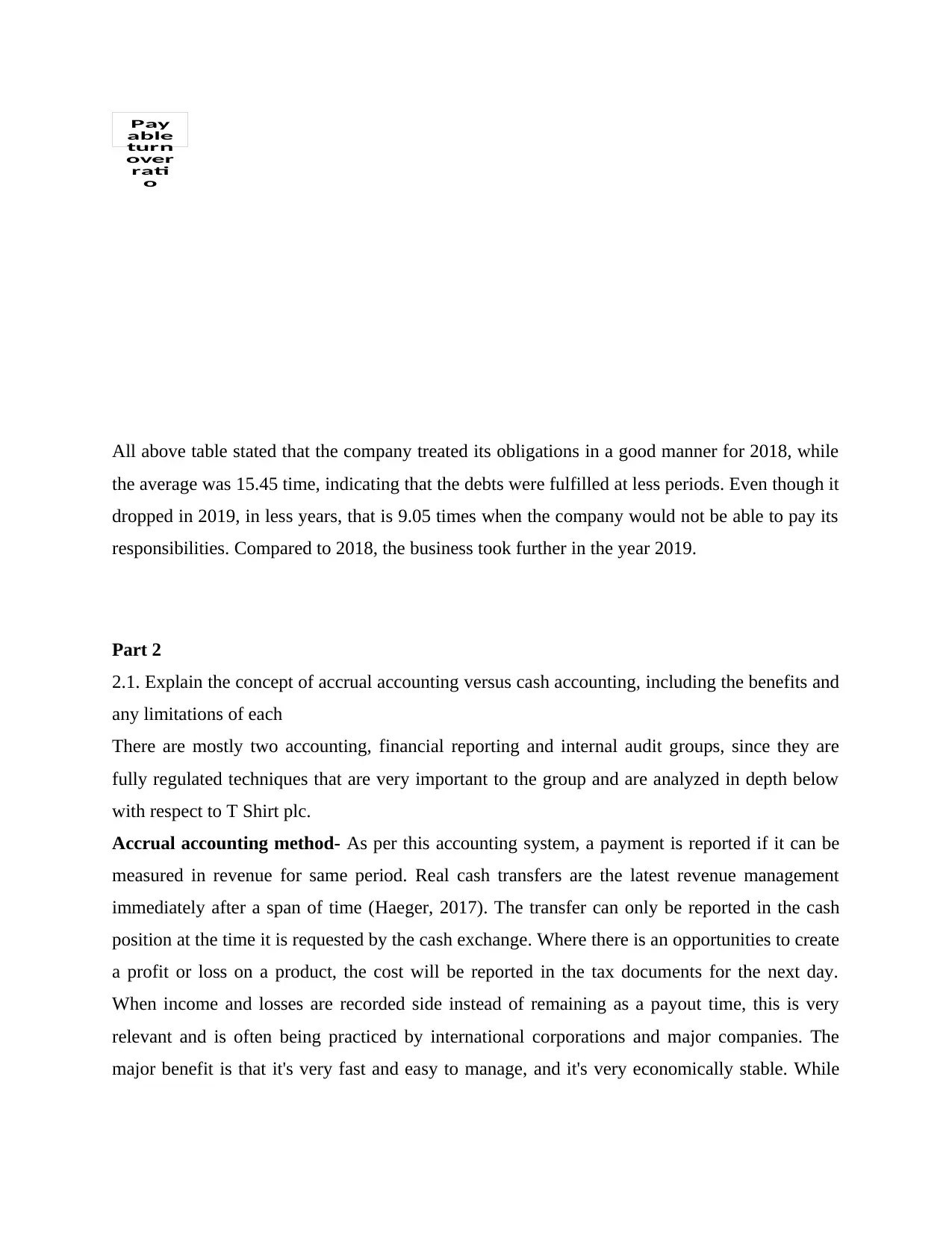
Pay
able
turn
over
rati
o
All above table stated that the company treated its obligations in a good manner for 2018, while
the average was 15.45 time, indicating that the debts were fulfilled at less periods. Even though it
dropped in 2019, in less years, that is 9.05 times when the company would not be able to pay its
responsibilities. Compared to 2018, the business took further in the year 2019.
Part 2
2.1. Explain the concept of accrual accounting versus cash accounting, including the benefits and
any limitations of each
There are mostly two accounting, financial reporting and internal audit groups, since they are
fully regulated techniques that are very important to the group and are analyzed in depth below
with respect to T Shirt plc.
Accrual accounting method- As per this accounting system, a payment is reported if it can be
measured in revenue for same period. Real cash transfers are the latest revenue management
immediately after a span of time (Haeger, 2017). The transfer can only be reported in the cash
position at the time it is requested by the cash exchange. Where there is an opportunities to create
a profit or loss on a product, the cost will be reported in the tax documents for the next day.
When income and losses are recorded side instead of remaining as a payout time, this is very
relevant and is often being practiced by international corporations and major companies. The
major benefit is that it's very fast and easy to manage, and it's very economically stable. While
able
turn
over
rati
o
All above table stated that the company treated its obligations in a good manner for 2018, while
the average was 15.45 time, indicating that the debts were fulfilled at less periods. Even though it
dropped in 2019, in less years, that is 9.05 times when the company would not be able to pay its
responsibilities. Compared to 2018, the business took further in the year 2019.
Part 2
2.1. Explain the concept of accrual accounting versus cash accounting, including the benefits and
any limitations of each
There are mostly two accounting, financial reporting and internal audit groups, since they are
fully regulated techniques that are very important to the group and are analyzed in depth below
with respect to T Shirt plc.
Accrual accounting method- As per this accounting system, a payment is reported if it can be
measured in revenue for same period. Real cash transfers are the latest revenue management
immediately after a span of time (Haeger, 2017). The transfer can only be reported in the cash
position at the time it is requested by the cash exchange. Where there is an opportunities to create
a profit or loss on a product, the cost will be reported in the tax documents for the next day.
When income and losses are recorded side instead of remaining as a payout time, this is very
relevant and is often being practiced by international corporations and major companies. The
major benefit is that it's very fast and easy to manage, and it's very economically stable. While
Paraphrase This Document
Need a fresh take? Get an instant paraphrase of this document with our AI Paraphraser
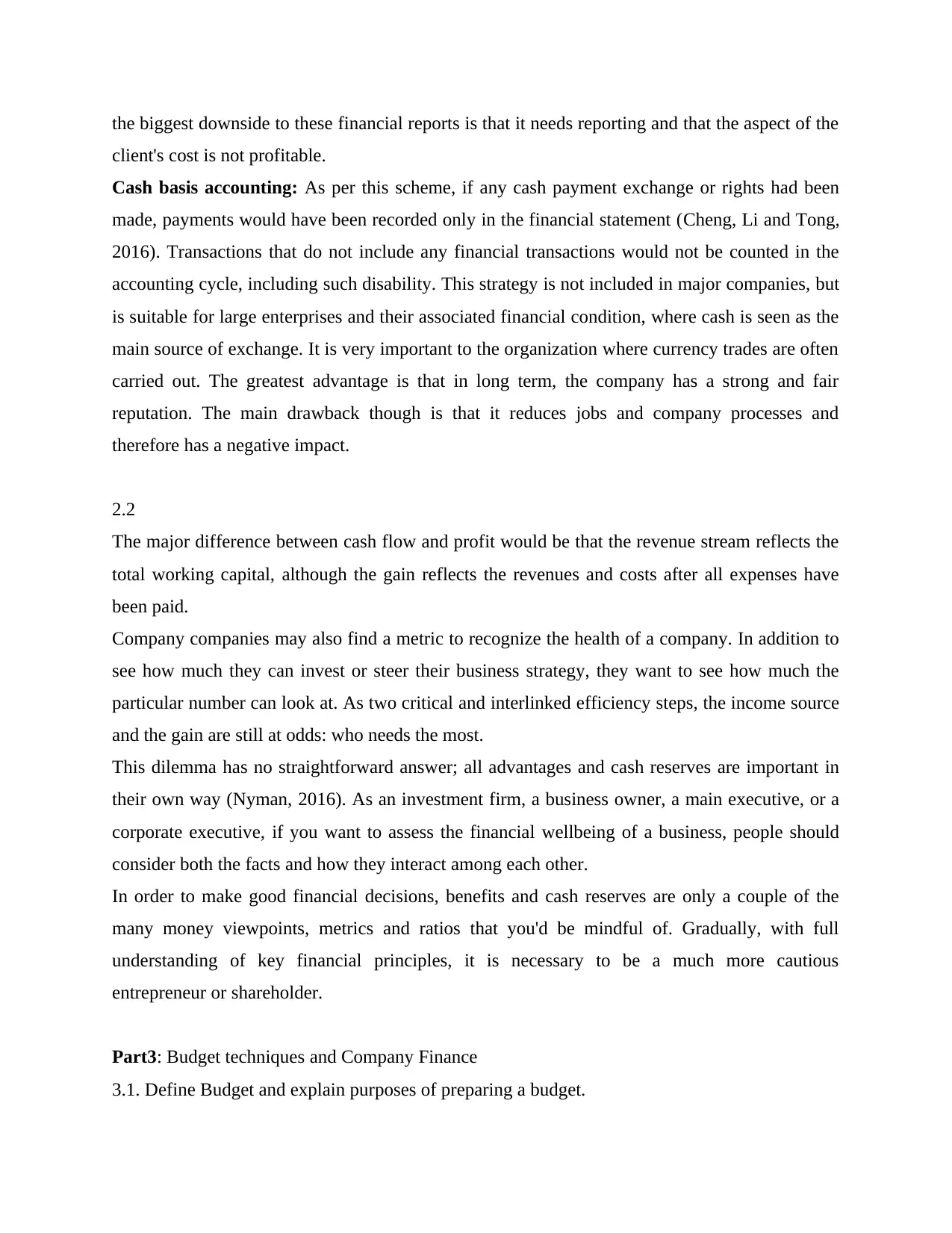
the biggest downside to these financial reports is that it needs reporting and that the aspect of the
client's cost is not profitable.
Cash basis accounting: As per this scheme, if any cash payment exchange or rights had been
made, payments would have been recorded only in the financial statement (Cheng, Li and Tong,
2016). Transactions that do not include any financial transactions would not be counted in the
accounting cycle, including such disability. This strategy is not included in major companies, but
is suitable for large enterprises and their associated financial condition, where cash is seen as the
main source of exchange. It is very important to the organization where currency trades are often
carried out. The greatest advantage is that in long term, the company has a strong and fair
reputation. The main drawback though is that it reduces jobs and company processes and
therefore has a negative impact.
2.2
The major difference between cash flow and profit would be that the revenue stream reflects the
total working capital, although the gain reflects the revenues and costs after all expenses have
been paid.
Company companies may also find a metric to recognize the health of a company. In addition to
see how much they can invest or steer their business strategy, they want to see how much the
particular number can look at. As two critical and interlinked efficiency steps, the income source
and the gain are still at odds: who needs the most.
This dilemma has no straightforward answer; all advantages and cash reserves are important in
their own way (Nyman, 2016). As an investment firm, a business owner, a main executive, or a
corporate executive, if you want to assess the financial wellbeing of a business, people should
consider both the facts and how they interact among each other.
In order to make good financial decisions, benefits and cash reserves are only a couple of the
many money viewpoints, metrics and ratios that you'd be mindful of. Gradually, with full
understanding of key financial principles, it is necessary to be a much more cautious
entrepreneur or shareholder.
Part3: Budget techniques and Company Finance
3.1. Define Budget and explain purposes of preparing a budget.
client's cost is not profitable.
Cash basis accounting: As per this scheme, if any cash payment exchange or rights had been
made, payments would have been recorded only in the financial statement (Cheng, Li and Tong,
2016). Transactions that do not include any financial transactions would not be counted in the
accounting cycle, including such disability. This strategy is not included in major companies, but
is suitable for large enterprises and their associated financial condition, where cash is seen as the
main source of exchange. It is very important to the organization where currency trades are often
carried out. The greatest advantage is that in long term, the company has a strong and fair
reputation. The main drawback though is that it reduces jobs and company processes and
therefore has a negative impact.
2.2
The major difference between cash flow and profit would be that the revenue stream reflects the
total working capital, although the gain reflects the revenues and costs after all expenses have
been paid.
Company companies may also find a metric to recognize the health of a company. In addition to
see how much they can invest or steer their business strategy, they want to see how much the
particular number can look at. As two critical and interlinked efficiency steps, the income source
and the gain are still at odds: who needs the most.
This dilemma has no straightforward answer; all advantages and cash reserves are important in
their own way (Nyman, 2016). As an investment firm, a business owner, a main executive, or a
corporate executive, if you want to assess the financial wellbeing of a business, people should
consider both the facts and how they interact among each other.
In order to make good financial decisions, benefits and cash reserves are only a couple of the
many money viewpoints, metrics and ratios that you'd be mindful of. Gradually, with full
understanding of key financial principles, it is necessary to be a much more cautious
entrepreneur or shareholder.
Part3: Budget techniques and Company Finance
3.1. Define Budget and explain purposes of preparing a budget.
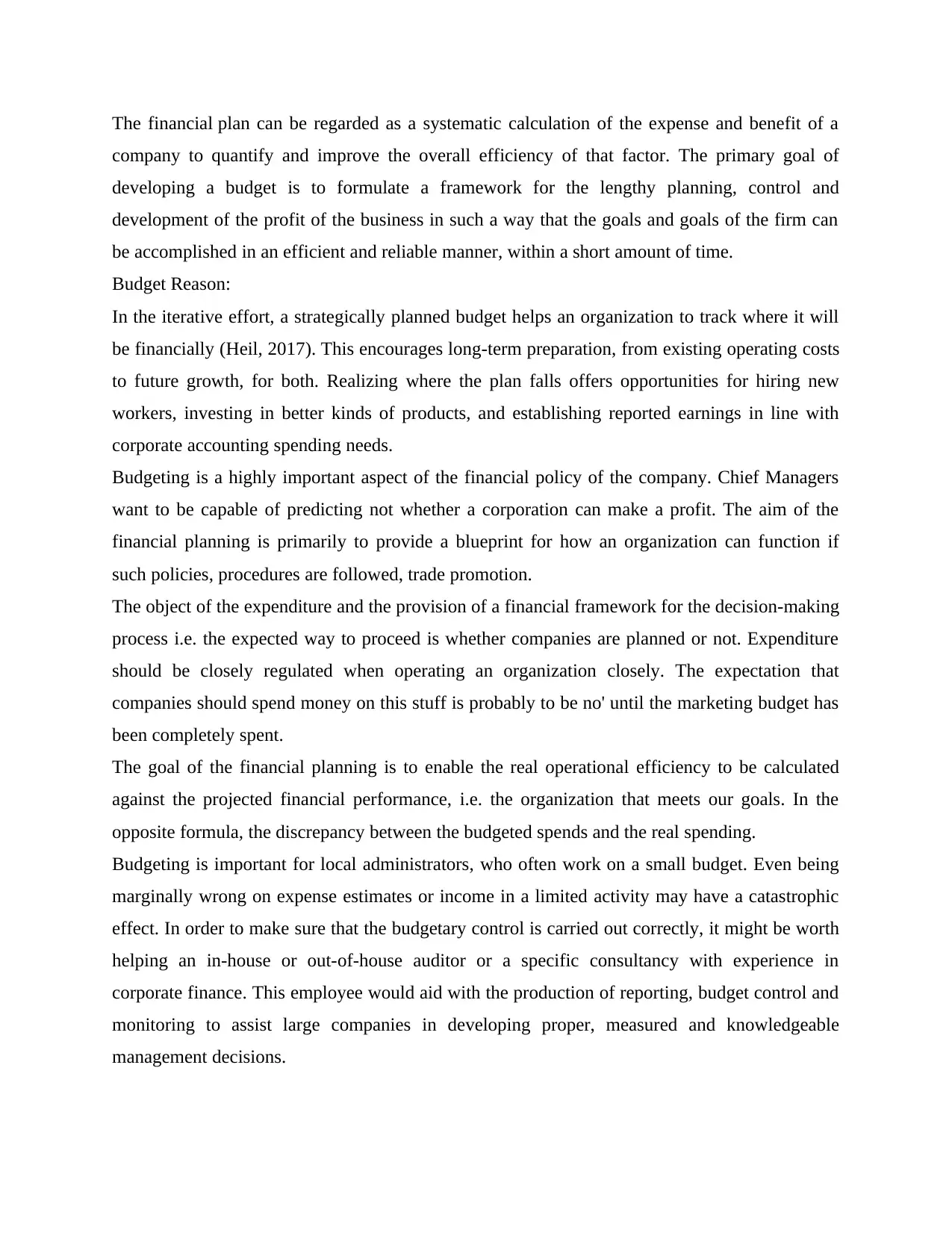
The financial plan can be regarded as a systematic calculation of the expense and benefit of a
company to quantify and improve the overall efficiency of that factor. The primary goal of
developing a budget is to formulate a framework for the lengthy planning, control and
development of the profit of the business in such a way that the goals and goals of the firm can
be accomplished in an efficient and reliable manner, within a short amount of time.
Budget Reason:
In the iterative effort, a strategically planned budget helps an organization to track where it will
be financially (Heil, 2017). This encourages long-term preparation, from existing operating costs
to future growth, for both. Realizing where the plan falls offers opportunities for hiring new
workers, investing in better kinds of products, and establishing reported earnings in line with
corporate accounting spending needs.
Budgeting is a highly important aspect of the financial policy of the company. Chief Managers
want to be capable of predicting not whether a corporation can make a profit. The aim of the
financial planning is primarily to provide a blueprint for how an organization can function if
such policies, procedures are followed, trade promotion.
The object of the expenditure and the provision of a financial framework for the decision-making
process i.e. the expected way to proceed is whether companies are planned or not. Expenditure
should be closely regulated when operating an organization closely. The expectation that
companies should spend money on this stuff is probably to be no' until the marketing budget has
been completely spent.
The goal of the financial planning is to enable the real operational efficiency to be calculated
against the projected financial performance, i.e. the organization that meets our goals. In the
opposite formula, the discrepancy between the budgeted spends and the real spending.
Budgeting is important for local administrators, who often work on a small budget. Even being
marginally wrong on expense estimates or income in a limited activity may have a catastrophic
effect. In order to make sure that the budgetary control is carried out correctly, it might be worth
helping an in-house or out-of-house auditor or a specific consultancy with experience in
corporate finance. This employee would aid with the production of reporting, budget control and
monitoring to assist large companies in developing proper, measured and knowledgeable
management decisions.
company to quantify and improve the overall efficiency of that factor. The primary goal of
developing a budget is to formulate a framework for the lengthy planning, control and
development of the profit of the business in such a way that the goals and goals of the firm can
be accomplished in an efficient and reliable manner, within a short amount of time.
Budget Reason:
In the iterative effort, a strategically planned budget helps an organization to track where it will
be financially (Heil, 2017). This encourages long-term preparation, from existing operating costs
to future growth, for both. Realizing where the plan falls offers opportunities for hiring new
workers, investing in better kinds of products, and establishing reported earnings in line with
corporate accounting spending needs.
Budgeting is a highly important aspect of the financial policy of the company. Chief Managers
want to be capable of predicting not whether a corporation can make a profit. The aim of the
financial planning is primarily to provide a blueprint for how an organization can function if
such policies, procedures are followed, trade promotion.
The object of the expenditure and the provision of a financial framework for the decision-making
process i.e. the expected way to proceed is whether companies are planned or not. Expenditure
should be closely regulated when operating an organization closely. The expectation that
companies should spend money on this stuff is probably to be no' until the marketing budget has
been completely spent.
The goal of the financial planning is to enable the real operational efficiency to be calculated
against the projected financial performance, i.e. the organization that meets our goals. In the
opposite formula, the discrepancy between the budgeted spends and the real spending.
Budgeting is important for local administrators, who often work on a small budget. Even being
marginally wrong on expense estimates or income in a limited activity may have a catastrophic
effect. In order to make sure that the budgetary control is carried out correctly, it might be worth
helping an in-house or out-of-house auditor or a specific consultancy with experience in
corporate finance. This employee would aid with the production of reporting, budget control and
monitoring to assist large companies in developing proper, measured and knowledgeable
management decisions.
⊘ This is a preview!⊘
Do you want full access?
Subscribe today to unlock all pages.

Trusted by 1+ million students worldwide
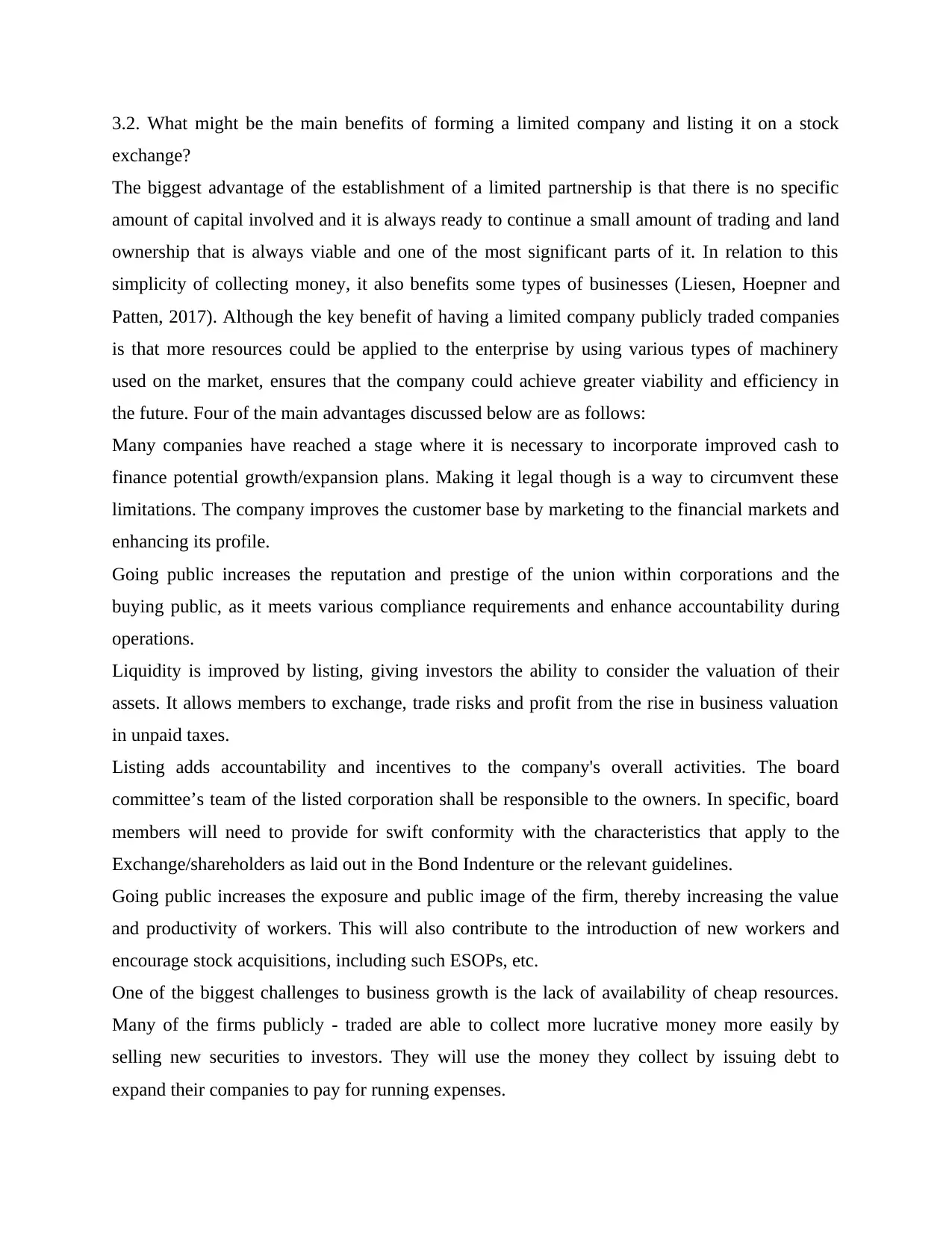
3.2. What might be the main benefits of forming a limited company and listing it on a stock
exchange?
The biggest advantage of the establishment of a limited partnership is that there is no specific
amount of capital involved and it is always ready to continue a small amount of trading and land
ownership that is always viable and one of the most significant parts of it. In relation to this
simplicity of collecting money, it also benefits some types of businesses (Liesen, Hoepner and
Patten, 2017). Although the key benefit of having a limited company publicly traded companies
is that more resources could be applied to the enterprise by using various types of machinery
used on the market, ensures that the company could achieve greater viability and efficiency in
the future. Four of the main advantages discussed below are as follows:
Many companies have reached a stage where it is necessary to incorporate improved cash to
finance potential growth/expansion plans. Making it legal though is a way to circumvent these
limitations. The company improves the customer base by marketing to the financial markets and
enhancing its profile.
Going public increases the reputation and prestige of the union within corporations and the
buying public, as it meets various compliance requirements and enhance accountability during
operations.
Liquidity is improved by listing, giving investors the ability to consider the valuation of their
assets. It allows members to exchange, trade risks and profit from the rise in business valuation
in unpaid taxes.
Listing adds accountability and incentives to the company's overall activities. The board
committee’s team of the listed corporation shall be responsible to the owners. In specific, board
members will need to provide for swift conformity with the characteristics that apply to the
Exchange/shareholders as laid out in the Bond Indenture or the relevant guidelines.
Going public increases the exposure and public image of the firm, thereby increasing the value
and productivity of workers. This will also contribute to the introduction of new workers and
encourage stock acquisitions, including such ESOPs, etc.
One of the biggest challenges to business growth is the lack of availability of cheap resources.
Many of the firms publicly - traded are able to collect more lucrative money more easily by
selling new securities to investors. They will use the money they collect by issuing debt to
expand their companies to pay for running expenses.
exchange?
The biggest advantage of the establishment of a limited partnership is that there is no specific
amount of capital involved and it is always ready to continue a small amount of trading and land
ownership that is always viable and one of the most significant parts of it. In relation to this
simplicity of collecting money, it also benefits some types of businesses (Liesen, Hoepner and
Patten, 2017). Although the key benefit of having a limited company publicly traded companies
is that more resources could be applied to the enterprise by using various types of machinery
used on the market, ensures that the company could achieve greater viability and efficiency in
the future. Four of the main advantages discussed below are as follows:
Many companies have reached a stage where it is necessary to incorporate improved cash to
finance potential growth/expansion plans. Making it legal though is a way to circumvent these
limitations. The company improves the customer base by marketing to the financial markets and
enhancing its profile.
Going public increases the reputation and prestige of the union within corporations and the
buying public, as it meets various compliance requirements and enhance accountability during
operations.
Liquidity is improved by listing, giving investors the ability to consider the valuation of their
assets. It allows members to exchange, trade risks and profit from the rise in business valuation
in unpaid taxes.
Listing adds accountability and incentives to the company's overall activities. The board
committee’s team of the listed corporation shall be responsible to the owners. In specific, board
members will need to provide for swift conformity with the characteristics that apply to the
Exchange/shareholders as laid out in the Bond Indenture or the relevant guidelines.
Going public increases the exposure and public image of the firm, thereby increasing the value
and productivity of workers. This will also contribute to the introduction of new workers and
encourage stock acquisitions, including such ESOPs, etc.
One of the biggest challenges to business growth is the lack of availability of cheap resources.
Many of the firms publicly - traded are able to collect more lucrative money more easily by
selling new securities to investors. They will use the money they collect by issuing debt to
expand their companies to pay for running expenses.
Paraphrase This Document
Need a fresh take? Get an instant paraphrase of this document with our AI Paraphraser
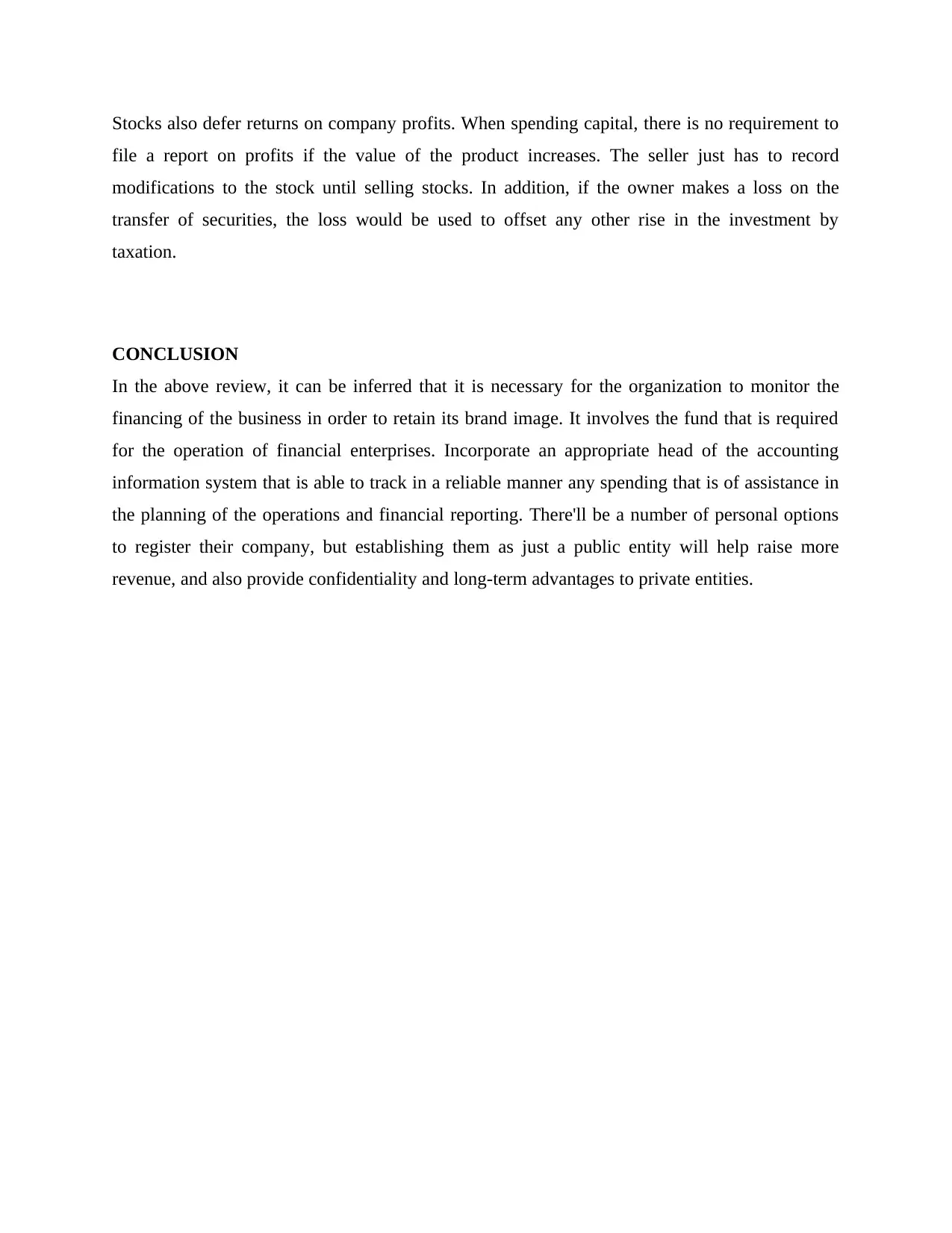
Stocks also defer returns on company profits. When spending capital, there is no requirement to
file a report on profits if the value of the product increases. The seller just has to record
modifications to the stock until selling stocks. In addition, if the owner makes a loss on the
transfer of securities, the loss would be used to offset any other rise in the investment by
taxation.
CONCLUSION
In the above review, it can be inferred that it is necessary for the organization to monitor the
financing of the business in order to retain its brand image. It involves the fund that is required
for the operation of financial enterprises. Incorporate an appropriate head of the accounting
information system that is able to track in a reliable manner any spending that is of assistance in
the planning of the operations and financial reporting. There'll be a number of personal options
to register their company, but establishing them as just a public entity will help raise more
revenue, and also provide confidentiality and long-term advantages to private entities.
file a report on profits if the value of the product increases. The seller just has to record
modifications to the stock until selling stocks. In addition, if the owner makes a loss on the
transfer of securities, the loss would be used to offset any other rise in the investment by
taxation.
CONCLUSION
In the above review, it can be inferred that it is necessary for the organization to monitor the
financing of the business in order to retain its brand image. It involves the fund that is required
for the operation of financial enterprises. Incorporate an appropriate head of the accounting
information system that is able to track in a reliable manner any spending that is of assistance in
the planning of the operations and financial reporting. There'll be a number of personal options
to register their company, but establishing them as just a public entity will help raise more
revenue, and also provide confidentiality and long-term advantages to private entities.
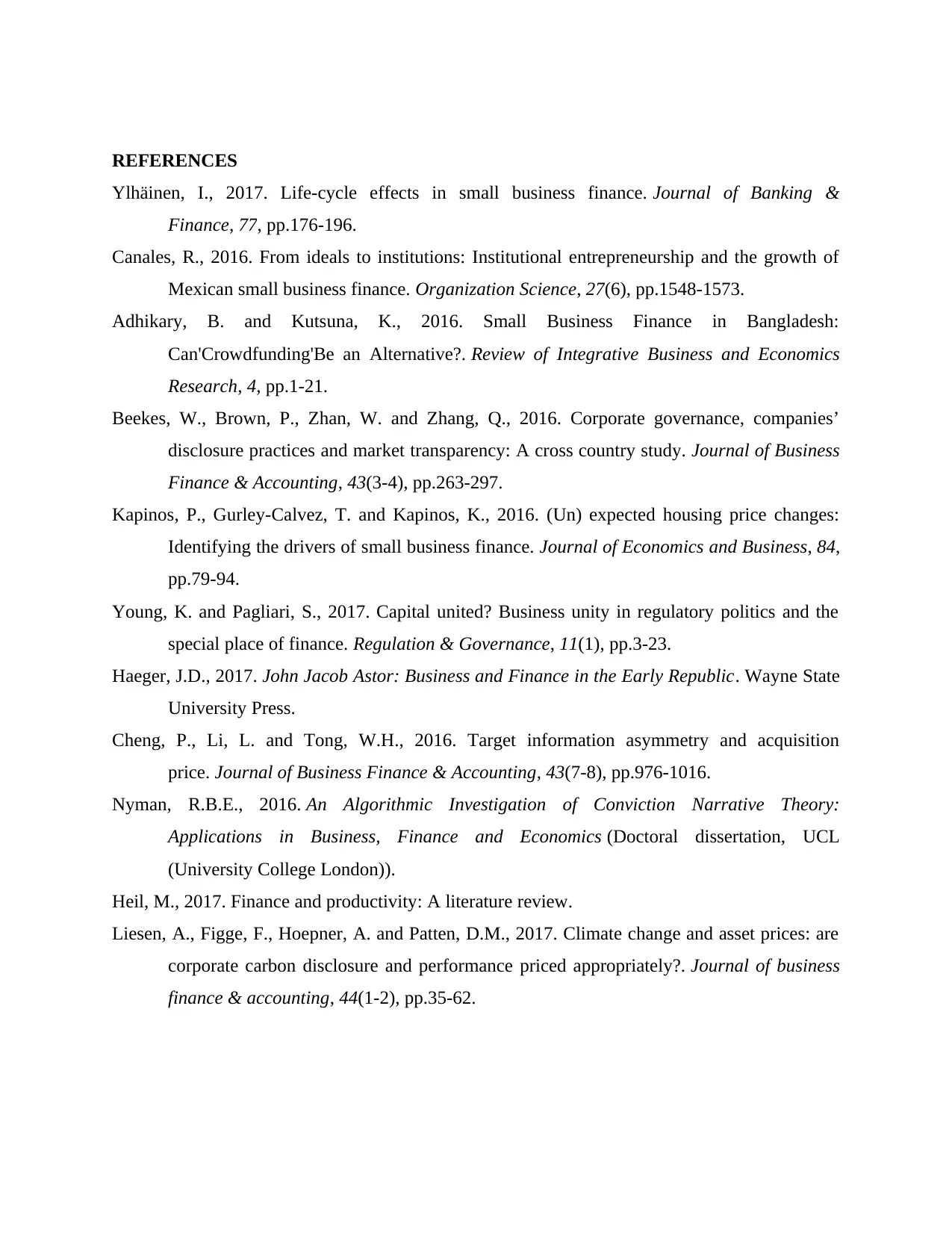
REFERENCES
Ylhäinen, I., 2017. Life-cycle effects in small business finance. Journal of Banking &
Finance, 77, pp.176-196.
Canales, R., 2016. From ideals to institutions: Institutional entrepreneurship and the growth of
Mexican small business finance. Organization Science, 27(6), pp.1548-1573.
Adhikary, B. and Kutsuna, K., 2016. Small Business Finance in Bangladesh:
Can'Crowdfunding'Be an Alternative?. Review of Integrative Business and Economics
Research, 4, pp.1-21.
Beekes, W., Brown, P., Zhan, W. and Zhang, Q., 2016. Corporate governance, companies’
disclosure practices and market transparency: A cross country study. Journal of Business
Finance & Accounting, 43(3-4), pp.263-297.
Kapinos, P., Gurley-Calvez, T. and Kapinos, K., 2016. (Un) expected housing price changes:
Identifying the drivers of small business finance. Journal of Economics and Business, 84,
pp.79-94.
Young, K. and Pagliari, S., 2017. Capital united? Business unity in regulatory politics and the
special place of finance. Regulation & Governance, 11(1), pp.3-23.
Haeger, J.D., 2017. John Jacob Astor: Business and Finance in the Early Republic. Wayne State
University Press.
Cheng, P., Li, L. and Tong, W.H., 2016. Target information asymmetry and acquisition
price. Journal of Business Finance & Accounting, 43(7-8), pp.976-1016.
Nyman, R.B.E., 2016. An Algorithmic Investigation of Conviction Narrative Theory:
Applications in Business, Finance and Economics (Doctoral dissertation, UCL
(University College London)).
Heil, M., 2017. Finance and productivity: A literature review.
Liesen, A., Figge, F., Hoepner, A. and Patten, D.M., 2017. Climate change and asset prices: are
corporate carbon disclosure and performance priced appropriately?. Journal of business
finance & accounting, 44(1-2), pp.35-62.
Ylhäinen, I., 2017. Life-cycle effects in small business finance. Journal of Banking &
Finance, 77, pp.176-196.
Canales, R., 2016. From ideals to institutions: Institutional entrepreneurship and the growth of
Mexican small business finance. Organization Science, 27(6), pp.1548-1573.
Adhikary, B. and Kutsuna, K., 2016. Small Business Finance in Bangladesh:
Can'Crowdfunding'Be an Alternative?. Review of Integrative Business and Economics
Research, 4, pp.1-21.
Beekes, W., Brown, P., Zhan, W. and Zhang, Q., 2016. Corporate governance, companies’
disclosure practices and market transparency: A cross country study. Journal of Business
Finance & Accounting, 43(3-4), pp.263-297.
Kapinos, P., Gurley-Calvez, T. and Kapinos, K., 2016. (Un) expected housing price changes:
Identifying the drivers of small business finance. Journal of Economics and Business, 84,
pp.79-94.
Young, K. and Pagliari, S., 2017. Capital united? Business unity in regulatory politics and the
special place of finance. Regulation & Governance, 11(1), pp.3-23.
Haeger, J.D., 2017. John Jacob Astor: Business and Finance in the Early Republic. Wayne State
University Press.
Cheng, P., Li, L. and Tong, W.H., 2016. Target information asymmetry and acquisition
price. Journal of Business Finance & Accounting, 43(7-8), pp.976-1016.
Nyman, R.B.E., 2016. An Algorithmic Investigation of Conviction Narrative Theory:
Applications in Business, Finance and Economics (Doctoral dissertation, UCL
(University College London)).
Heil, M., 2017. Finance and productivity: A literature review.
Liesen, A., Figge, F., Hoepner, A. and Patten, D.M., 2017. Climate change and asset prices: are
corporate carbon disclosure and performance priced appropriately?. Journal of business
finance & accounting, 44(1-2), pp.35-62.
⊘ This is a preview!⊘
Do you want full access?
Subscribe today to unlock all pages.

Trusted by 1+ million students worldwide
1 out of 12
Related Documents
Your All-in-One AI-Powered Toolkit for Academic Success.
+13062052269
info@desklib.com
Available 24*7 on WhatsApp / Email
![[object Object]](/_next/static/media/star-bottom.7253800d.svg)
Unlock your academic potential
Copyright © 2020–2025 A2Z Services. All Rights Reserved. Developed and managed by ZUCOL.





